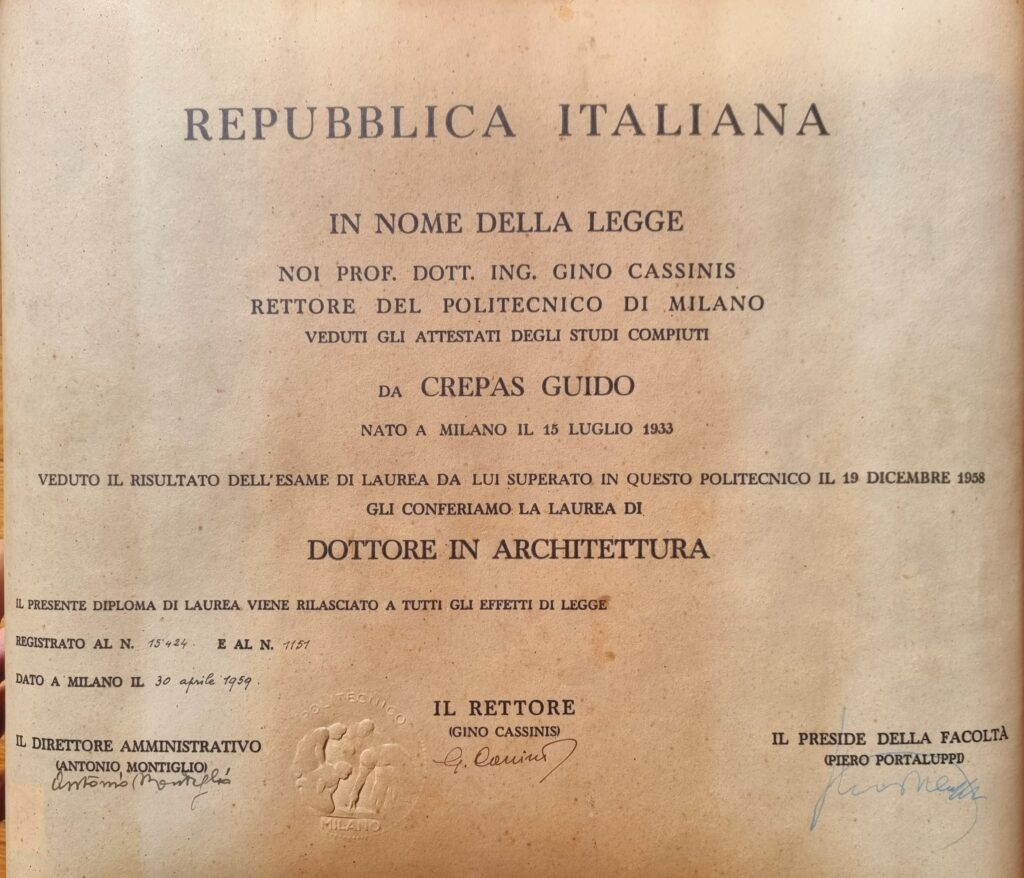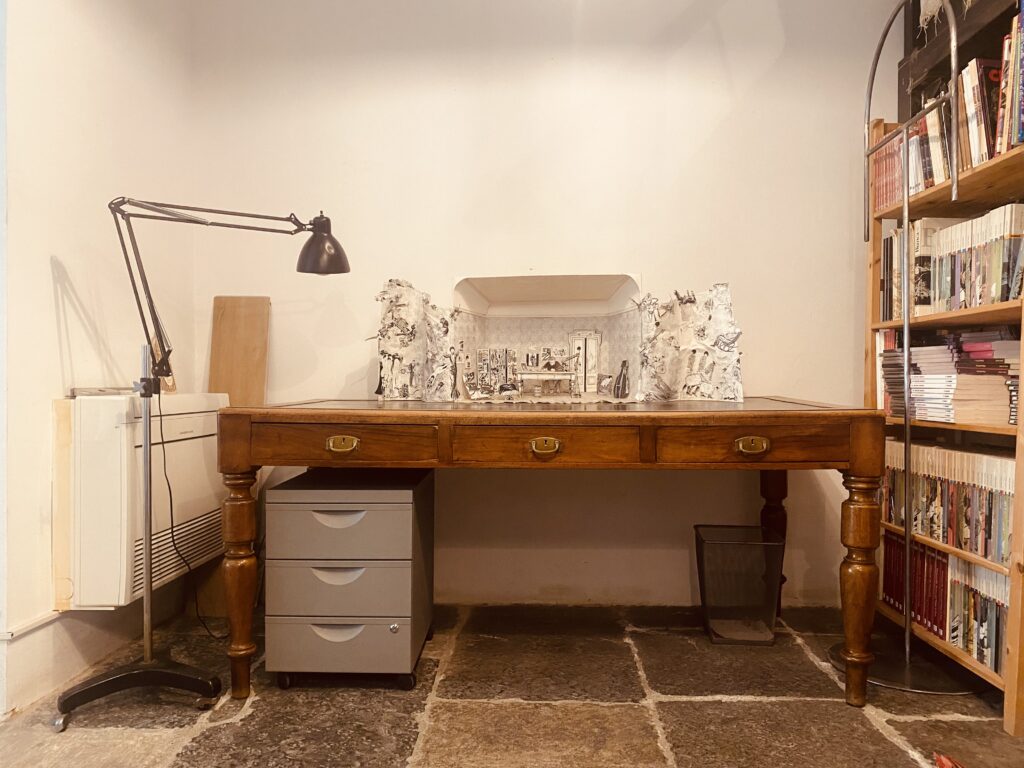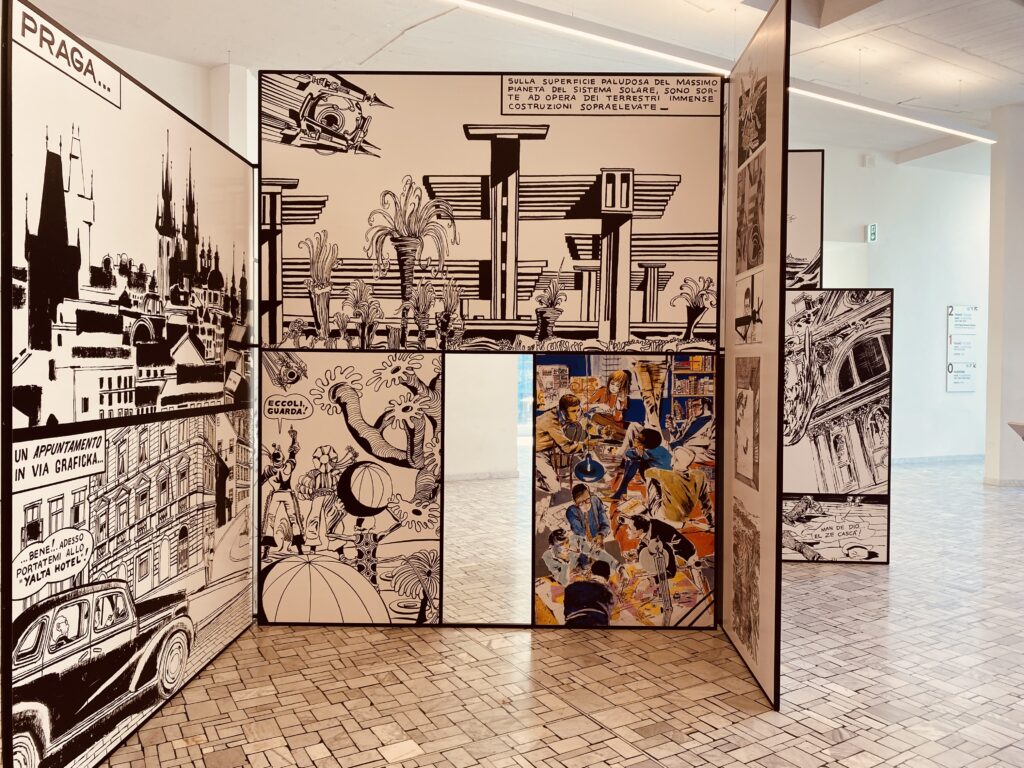Night Watchman, Doorman, Travel Agency, Telephone. These are some of the handwritten notes, in the rounded letters of a comic book, found not in a speech bubble but in the geometric lines of the floor plan of a building in Via Laghetto in Milan. A page in the same series reads: "Architectural Composition Course 2, 1956-1957, Guido Crepas, Degree Theme".
The characters and directions included in the plan show us that the 24-year-old Guido Crepax was already thinking about who exactly would live between those precise lines: it is a preview of his nature as an author, the nature of someone who wants above all to be the architect of stories. "About five years ago we found these plans in the loft of our mother's house," says Caterina, the daughter of the great illustrator and Politecnico Alumnus, "and it is always a thrill when we find something that shows us a new aspect of our father”.
Giacomo, who curates and promotes the Crepax archive along with Caterina and their other brother Antonio, gives a summary of his father’s life after graduation: "After finishing his studies at the Politecnico, as well as already working as an illustrator in the advertising and record industry, our father started working for architects, creating illustrations for them, which is now done by computers. We could say that he was the 'render-hand'”. In recent years, Crepax, the illustrator and the man, has reappeared at the Politecnico in a series of exhibitions, the latest of which is entitled "Guido Crepax, Architetto del Fumetto" (Guido Crepax, Architect of Comic Strips) and is a recognition of the works of an entire career, searching for the hand of the architect in contrast to that of the illustrator. "Celebrating him in the place where he studied is very valuable," explains Giacomo, "because it was here that he began to experiment, and here that he learnt many of the historical fundamentals of architecture and design which entered directly into his work. We therefore think the period of his education has to be retold. And besides, my sister and I are also Alumni, both architecture graduates”.
Switching thus into his professional role, he comments on another of his father’s drawings, which shows the view of the building: "The starting point was a kind of shopping centre that later developed into a residential tower. The design is interesting: it features curved side elements, very soft, that seem to evoke the architecture of Sant'Elia. I would describe it as a project that fully captures the futurist idea of the 1950s, made up of transparencies that also emphasise the structural part of the building: the voids, typical of the rationalist architecture of that period, the modern parts visible through the glass windows and the solid structure of the reinforced concrete pillars”. Elements of the comics to come can also be seen in this drawing: an American car, the clothes being worn, the Hotel Sforza sign and the glimpse of the Duomo in the background, squeezed in between two other buildings.

His academic background emerges here and there: in a drawing of Valentina strolling in the Missori area, behind her is Torre Velasca, built by Crepax’s thesis advisor, the Alumnus Ernesto Nathan Rogers. A frame of a man at a drafting machine brings us another scrap of biography, “His grandfather was an engineer. In fact, before enrolling in architecture, our father had taken a year of engineering, but was very unhappy with it,” Caterina reveals. "However, his whole life he made his drawings at his grandfather's actual desk, which is now in the architecture studio where I work," says Giacomo. In this stream of memories and references, Caterina says: "In the library at home we always found books on architecture, which we then used in turn. For him, design books were the best source of inspiration, because he was interested in drawing interiors and people in their environments, to also tell stories through design objects, wallpapers and lamps. Many of them were design pieces from our house, which we used to find in the comics”. The Arco lamp, the Le Corbusier sofas, the Brionvega television and the Magistretti bed were references that are mixed with more personal inspirations, as Caterina recounts: "There was an armchair with a footstool on which our mother used to read, opposite the table on which our father used to draw, and so that prompted a dialogue between reality and paper". Showing a drawing with the city of Prague, Giacomo explains: “Since he hardly ever left his studio, he would ask for photos of our trips abroad, which then became the locations of Valentina's adventures”.


Two other drawings help us to place him: portraits of Gropius and of Frank Lloyd Wright, the latter pictured next to Fallingwater. The tools of his trade were those of the architect's trade: ink, sheets of tracing paper and the razor blades with which he would scratch them, a compass and technical pens. "He used to lay out the very edges of the frames in straight lines with the corners flat,” observes Giacomo. “His drawings are almost like sections, floor plans where things happen in the individual frames. For example, there is a drawing with a bed at the centre, with Valentina and her companion on it, and from underneath come other side views of the bed. Or the choice to insert a drawing of a spiral staircase by fitting it into a long, narrow panel tells us about the architectural care he took in composing an image. On one sheet of paper there is a proper orthogonal projection of Valentina, which in this way becomes a device for moving, by turning it around, onto the next panel and the next episode.



He had an eye for detail, as Caterina explains well: "His stories take place mostly indoors and rarely outdoors, but when we are outside he always shows us places in fragments. There is no panorama of Milan cathedral, just the framing of a spire. He loved doors with handles, because they always had mystery behind them. He had invented underground people, who lived underground and emerged through gaps in the wallpaper and cracks in the wall or from the furniture, figures hidden in the floral patterns of a wallpaper”. What kind of architect would he have been? "His architecture would probably have been very rigorous but at the same time very imaginative, because he was very precise in his documentation but within his work he threw in things that were more of the future than of the present. Let’s say, maybe it would have been similar to the works of Oscar Niemeyer, like Brasilia,” Giacomo replies. Caterina adds: "He was always a member of the architects' association and he had signed the project for a house of his mother's in a small village in Versilia. But he had made a mistake in the design and put the main façade at the back and vice versa, he had reversed them”.
What lesson did he teach you?
«To perceive the whole, to get wrapped up in a reality that is composed of many things: architecture, politics and design, just like his stories. To bring this out, when we set up exhibitions we always try to physically bring the visitor into his world, almost as if they are entering the drawings, because he had no limits. Perhaps that is the greatest lesson: life is about sensing everything».